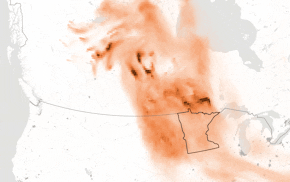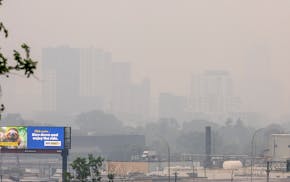OUTSIDE BOVEY, MINN.— Contractors were supposed to be hard at work this summer building drainage along the edge of the Canisteo Mine Pit, a complex of several former mines that threatens to flood this small Itasca County town.
But at the site off County Road 61, the machinery is idle. A collection of massive concrete culverts sit waiting, and a pile of sand stands nearby, a seemingly lost dune among stands of spruce and birch.
In this place, where a snowmobile trail rings the edge of the former mines, the Department of Natural Resources had a nearly $9 million plan to drain the pit. It was planning to construct a sand filter in a dry retention pond on the other side of the trail. That would allow water to run under County Road 61 and into the Prairie River without letting through invasive zebra mussels, which have infested Canisteo.
This spring, contractors started work on the filter site. They ran into a mix of clay and peat that might not be sturdy enough to support the sand, and could put pressure on the drainage pipes below, said Mike Liljegren, the DNR's assistant division director for lands and minerals.
When they hit the soupy soil in the first week of May, "We were like OK, we need to stop," he said.
The DNR may have to redesign the filter or be forced to build it elsewhere. Now, the agency is waiting on soil testing results from a consultant, Liljegren said. A fix that Bovey has been awaiting for decades is indefinitely stalled.
"It's a good thing they're trying to do," said Mayor Tony Yunk. "It should have been done 20 years ago."
Some residents of Bovey, population 862, moved away because they were worried about the pit, former mayor Bob Stein previously told the Minnesota Star Tribune. In 2011, water seeping up from the ground flooded some basements.
Now, the flood risk isn't top of mind for most, Yunk said — but it still needs to be addressed.
In the 1990s, water levels in the pit jumped rapidly, submerging a public boat ramp. At the edge of the pit on Tuesday, Yunk pointed to a few stubs of wood barely poking above the surface of the water. They were 15-foot-tall trees, he said.
In the past two years, water levels in the pit have mostly been falling because of the DNR's efforts. The agency has pumped water out of the pit in the winter, when zebra mussel larvae can't hitch a ride.
The agency reported pumping 4.7 billion gallons from the pit and a nearby wetland between 2022 and 2024. That effort kept the elevation of the water below 1,318 feet, the point at which it would overwhelm a drainage system in Bovey and water would start seeping up from the ground. The pit would overflow from the top at 1,324 feet, but it has not gotten close to that level in recent years.
Jesse Kessler, who manages 12,000 acres of owned and leased land around the pit for the company MagIron, said that pumping sometimes created an unsafe situation in which there was a gap between ice and the water level.
There are no public boat launches, but some still boat on the lake, and Yunk said he ice fishes there. Liljegren said the DNR doesn't tell people to stay away from the lake, except when it is pumping in the winter.
Kessler was pessimistic about whether the sand filter was worth the effort, pointing out that zebra mussels have already spread throughout the Mississippi River.
"It's very expensive, not just to build it, but it's complicated to maintain," he said.
But Liljegren said letting the mussels spread — even though some downstream waters already contain them — is illegal under state law. So the filter isn't optional.
Contractors had already built the rest of the drainage path from County Road 61 to the Prairie River, and Liljegren said the project was under budget so far. Unless the design changes drastically, he said the project shouldn't cost more than the original funding amount.
But until consultants figure out exactly what's underground, the sand, culverts and earth-mover will all sit, waiting.
dj](https://arc.stimg.co/startribunemedia/34QSKO44B2XKVNUZCO5SLJQSLY.jpg?h=91&w=145&fit=crop&bg=999&crop=faces)
Some adults will soon need a permit to operate a boat or personal watercraft in Minnesota

Drainage work stalls at mine pit that could flood small Iron Range town
Land snorkeling is the latest outdoors trend. So what exactly is it?

Watch wildfire smoke turn Minnesota's air quality into the worst in the U.S.

